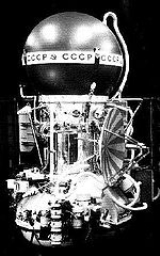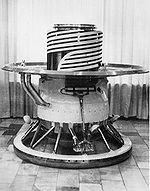
Venera 10
Encyclopedia
Venera 10 was a USSR unmanned space mission to Venus
. It consisted of an orbiter and a lander. It launched on June 14, 1975 03:00:31 UTC
.
The orbiter consisted of a cylinder with two solar panel wings and a high gain parabolic antenna attached to the curved surface. A bell-shaped unit holding propulsion systems was attached to the bottom of the cylinder, and mounted on top was a 2.4 meter sphere which held the landers.
 On October 23, 1975, this spacecraft was separated from the Orbiter, and landing was made with the sun near zenith, at 0517 UT, on October 25.
On October 23, 1975, this spacecraft was separated from the Orbiter, and landing was made with the sun near zenith, at 0517 UT, on October 25.
A system of circulating fluid was used to distribute the heat load. This system, plus precooling prior to entry, permitted operation of the spacecraft for 65 min after landing. During descent, heat dissipation and deceleration were accomplished sequentially by protective hemispheric shells, three parachutes, a disk-shaped drag brake, and a compressible, metal, doughnut-shaped, landing cushion.
It landed 2200 km from Venera 9 (within a 150 km radius of ), three days after its touchdown. Venera 10 measured a surface windspeed of 3.5 m/s. Other measurements included atmospheric pressure at various heights, and temperature, and surface light levels. Venera 10 was the second probe to send back black and white television pictures from the Venusian surface (after Venera 9). Venera 10 photographs showed lava
rocks of pancake shape with lava or other weathered rocks in between. Planned 360 degree panoramic pictures could not be taken because, as with Venera 9, one of two camera lens covers failed to come off, limiting pictures to 180 degrees.
Lander Payload:
Venus
Venus is the second planet from the Sun, orbiting it every 224.7 Earth days. The planet is named after Venus, the Roman goddess of love and beauty. After the Moon, it is the brightest natural object in the night sky, reaching an apparent magnitude of −4.6, bright enough to cast shadows...
. It consisted of an orbiter and a lander. It launched on June 14, 1975 03:00:31 UTC
Coordinated Universal Time
Coordinated Universal Time is the primary time standard by which the world regulates clocks and time. It is one of several closely related successors to Greenwich Mean Time. Computer servers, online services and other entities that rely on having a universally accepted time use UTC for that purpose...
.
Orbiter
The orbiter entered Venus orbit on October 23, 1975. Its mission was to serve as a communications relay for the lander and to explore cloud layers and atmospheric parameters with several instruments and experiments:- 1.6-2.8 μm IR Spectrometer
- 8-28 μm IR Radiometer
- 352 nm UV Photometer
- 2 Photopolarimeters (335-800 nm)
- 300-800 nm Spectrometer
- Lyman-α H/D Spectrometer
- Bistatic Radar Mapping
- CM, DM Radio Occultations
- Triaxial Magnetometer
- 345-380 nm UV Camera
- 355-445 nm Camera
- 6 Electrostatic Analyzers
- 2 Modulation IonIonAn ion is an atom or molecule in which the total number of electrons is not equal to the total number of protons, giving it a net positive or negative electrical charge. The name was given by physicist Michael Faraday for the substances that allow a current to pass between electrodes in a...
Traps - Low-Energy ProtonProtonThe proton is a subatomic particle with the symbol or and a positive electric charge of 1 elementary charge. One or more protons are present in the nucleus of each atom, along with neutrons. The number of protons in each atom is its atomic number....
/ AlphaAlpha WavesAlpha Waves is an early 3D game that combines labyrinthine exploration with platform gameplay. By most definitions of the genre it could be considered to be the first 3D platform game, released in 1990, 6 years before the genre's seminal classic Super Mario 64...
detector - Low-Energy ElectronElectronThe electron is a subatomic particle with a negative elementary electric charge. It has no known components or substructure; in other words, it is generally thought to be an elementary particle. An electron has a mass that is approximately 1/1836 that of the proton...
detector - 3 Semiconductor Counters
- 2 Gas-Discharge Counters
- Cherenkov Detector
The orbiter consisted of a cylinder with two solar panel wings and a high gain parabolic antenna attached to the curved surface. A bell-shaped unit holding propulsion systems was attached to the bottom of the cylinder, and mounted on top was a 2.4 meter sphere which held the landers.
Lander

A system of circulating fluid was used to distribute the heat load. This system, plus precooling prior to entry, permitted operation of the spacecraft for 65 min after landing. During descent, heat dissipation and deceleration were accomplished sequentially by protective hemispheric shells, three parachutes, a disk-shaped drag brake, and a compressible, metal, doughnut-shaped, landing cushion.
It landed 2200 km from Venera 9 (within a 150 km radius of ), three days after its touchdown. Venera 10 measured a surface windspeed of 3.5 m/s. Other measurements included atmospheric pressure at various heights, and temperature, and surface light levels. Venera 10 was the second probe to send back black and white television pictures from the Venusian surface (after Venera 9). Venera 10 photographs showed lava
Lava
Lava refers both to molten rock expelled by a volcano during an eruption and the resulting rock after solidification and cooling. This molten rock is formed in the interior of some planets, including Earth, and some of their satellites. When first erupted from a volcanic vent, lava is a liquid at...
rocks of pancake shape with lava or other weathered rocks in between. Planned 360 degree panoramic pictures could not be taken because, as with Venera 9, one of two camera lens covers failed to come off, limiting pictures to 180 degrees.
Lander Payload:
- Temperature and pressure sensors
- Accelerometer
- Visible / IR photometer - IOV-75
- Backscatter and multi-angle nephelometers - MNV-75
- P-11 Mass spectrometer - MAV-75
- Panoramic telephotometers (2, with lamps)
- Anemometer - ISV-75
- Gamma ray spectrometer - GS-12V
- Gamma ray densitometer - RP-75
- Radio Doppler experiment

